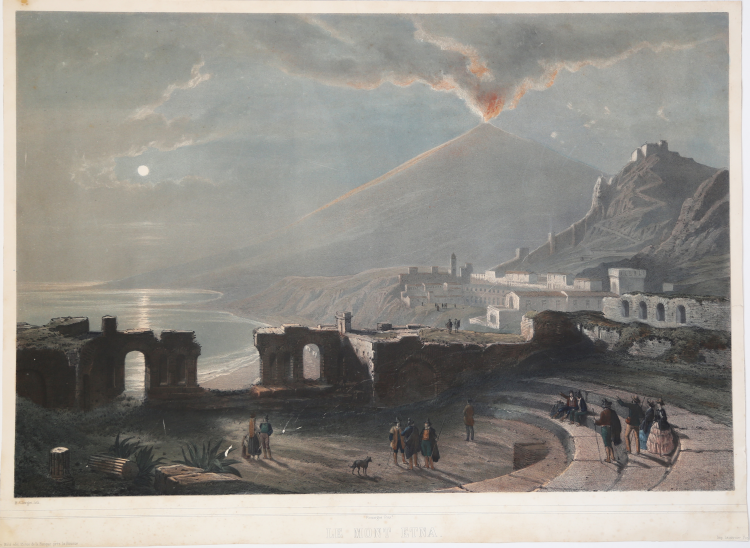



| Reference: | s29472 |
| Author | Joseph-Rose LEMERCIER |
| Year: | 1830 ca. |
| Zone: | Taormina |
| Printed: | Paris |
| Measures: | 610 x 450 mm |


| Reference: | s29472 |
| Author | Joseph-Rose LEMERCIER |
| Year: | 1830 ca. |
| Zone: | Taormina |
| Printed: | Paris |
| Measures: | 610 x 450 mm |
Night view of the city of Taormina with Etna, taken from Greek Theatre.
Published in Paris from Lemercier printing house, the view is taken from a painting by Emile Rouargue.
Joseph-Rose Lemercier (1803-1887) was one of the most important Parisian printers-lithographers of the 19th century. He worked for the greatest publishers and artists of his time. He played an important role in the diffusion and the generalization of the process of photolithography which made it possible to transfer a photographic image on a lithographic stone and to carry out thanks to that impressions with the printing ink of this image.
Tinted lithograph, finely hand coloured, in good condition. Rare.
Joseph-Rose LEMERCIER (1803-1887)
|
Joseph-Rose Lemercier (1803-1887) was one of the most important Parisian printers-lithographers of the 19th century. He worked for the greatest publishers and artists of his time. He played an important role in the diffusion and the generalization of the process of photolithography which made it possible to transfer a photographic image on a lithographic stone and to carry out thanks to that impressions with the printing ink of this image. Of modest origin, son of a Parisian basket maker, he was born in Paris on July 6th 1803. He was apprenticed to Édouard Knecht, nephew and successor of Aloys Senefelder, the inventor of lithography. In 1828, he started his own business and in 1831, he moved to 57, rue de Seine, in a former game of paume.
Between 1852 and 1855, he joined forces with the optician Lerebours, the chemist Barreswil and the chemist and photographer Alphonse Davanne to develop such a process, but the result - of a too long and complex implementation - was not industrially exploitable. In 1855, Alphonse Poitevin invented and patented a process that could be used industrially. Poitevin first tried to exploit his patent himself and opened a workshop in Paris. However, in October 1857, he sold his patent and his workshop to Lemercier.
Lemercier works for all the great French publishers of his time. He is the printer of artists such as Odilon Redon, Édouard Manet and Alphonse Mucha. Joseph-Rose Lemercier was made a knight of the Legion of Honor in 1847, then promoted to officer in 1878. His nephew, Alfred Lemercier, succeeded him at the head of the company, then, at his death, inherited it.
|
Joseph-Rose LEMERCIER (1803-1887)
|
Joseph-Rose Lemercier (1803-1887) was one of the most important Parisian printers-lithographers of the 19th century. He worked for the greatest publishers and artists of his time. He played an important role in the diffusion and the generalization of the process of photolithography which made it possible to transfer a photographic image on a lithographic stone and to carry out thanks to that impressions with the printing ink of this image. Of modest origin, son of a Parisian basket maker, he was born in Paris on July 6th 1803. He was apprenticed to Édouard Knecht, nephew and successor of Aloys Senefelder, the inventor of lithography. In 1828, he started his own business and in 1831, he moved to 57, rue de Seine, in a former game of paume.
Between 1852 and 1855, he joined forces with the optician Lerebours, the chemist Barreswil and the chemist and photographer Alphonse Davanne to develop such a process, but the result - of a too long and complex implementation - was not industrially exploitable. In 1855, Alphonse Poitevin invented and patented a process that could be used industrially. Poitevin first tried to exploit his patent himself and opened a workshop in Paris. However, in October 1857, he sold his patent and his workshop to Lemercier.
Lemercier works for all the great French publishers of his time. He is the printer of artists such as Odilon Redon, Édouard Manet and Alphonse Mucha. Joseph-Rose Lemercier was made a knight of the Legion of Honor in 1847, then promoted to officer in 1878. His nephew, Alfred Lemercier, succeeded him at the head of the company, then, at his death, inherited it.
|